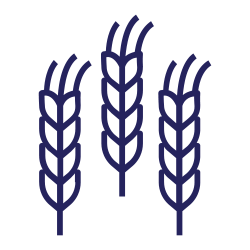Section Title
Staging for Pre-Harvest Glyphosate Application
Crop Types
- Wheat
Identifying the correct stage to apply pre-harvest glyphosate for perennial weed control can be challenging, especially if growth stage is variable within the field. For wheat and barley, pre-harvest glyphosate should be applied with the grain moisture content is less than 30%. This is also known as the hard dough stage and can be identified by the thumbnail test. If the kernel is firm, and a thumbnail impression remains on the kernel, the field is likely at the correct stage. At the end of the hard dough stage, kernels have reached their maximum dry weight, therefore final yield has been determined.

Figure 1. Kernels at various times during grain filling: a. watery ripe, b. late milk, c. soft dough, d. hard dough (loss of green colour) and e. ripe for harvest. Source: Dave Hansen, Growth and Development Guide for Spring Wheat.

Figure 2. Wheat grains through the ripening stages. From left to right: late milk, soft dough, hard dough, hard kernel and harvest ripe. Source: BBCH Staging Manual, Oklahoma State University
The first indicator that a wheat plant is at physiological maturity is when kernels lose their green colour, and a dark cell layer appears along the crease. It’s also important to note that kernels within the same head will mature at different times, with kernels in the middle maturing first.
A characteristic that indicates close proximity to physiological maturity is peduncle colour, which is the part of the stem just below the head. It will have changed from dark green to either very light green or yellow.
However, change in peduncle colour is NOT the most reliable indicator of physiological maturity, and should always be followed up with a fingernail test.

Figure 3. Left: Wheat kernels prior to (top) and at (bottom) physiological maturity (note darkened pigment strand). Right: Peduncle colour change associated with physiological maturity.
If glyphosate is applied to the crop prior to 30% moisture content, yield and quality parameters (examples: test weight and green kernels) can be reduced. Research at North Dakota State University in spring and durum wheat found that termination at 45% moisture caused a 1-2 lb reduction in test weight and a 10% reduction in grain yield. It’s also important to know that early application can result in glyphosate levels in the grain that are above maximum residue limits (MRLs), which could have implications depending on the target market.
With all that in mind, it is likely better to apply your glyphosate on the later side rather than too early. Depending on weather conditions, glyphosate can take up to two weeks for ideal weed control. However, under hot and dry conditions, grain could be harvested as little as seven days after application. Keeping weather forecasts and harvest timing in mind when planning your glyphosate pass is also important.
Additional Resources
Original article written by: Pam de Rocquigny, former Provincial Cereal Crops Specialist with Manitoba Agriculture (now MCA’s Chief Executive Officer)
Revised by: Jason Voogt, Owner/Lead Agonomist with Field 2 Field Agronomy Inc. and Mallorie Lewarne, Agronomy Extension Specialist-Cereal Crops with Manitoba Crop Alliance (MCA).










